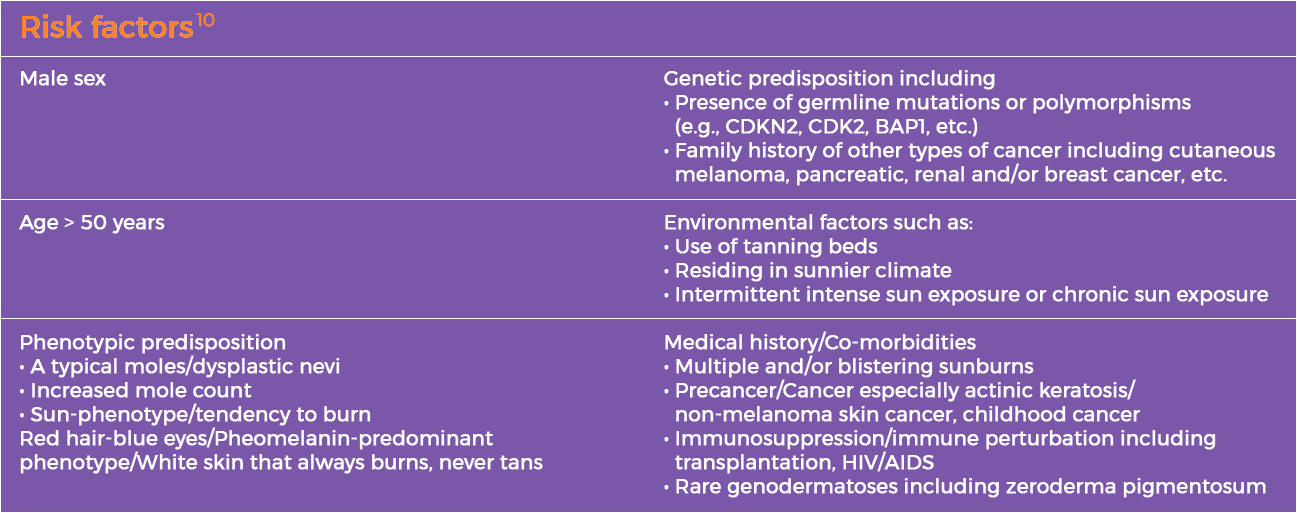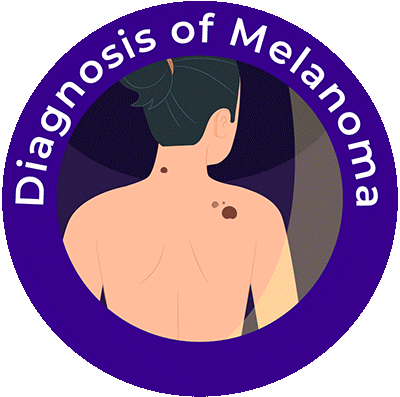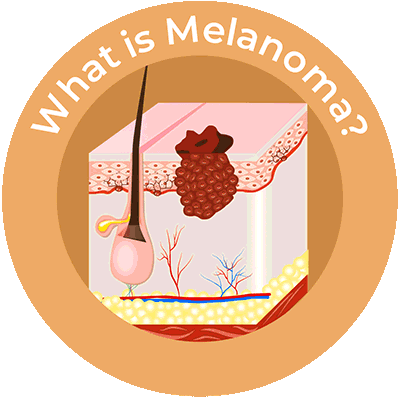This activity is provided by Med Learning Group.
This activity is supported by an independent medical education grant from Regeneron Pharmaceuticals, Inc.
Copyright © 2024 Med Learning Group. Built by Divigner. All Rights Reserved.
Pathophysiology of Melanoma
Melanoma is cancer of the melanocytes, cells that are derived from the neural crest and produce the pigment melanin. Most melanomas develop in the skin, but they can also develop from other sites where neural crest cells migrate, such as the uveal tract, gastrointestinal tract, and brain. The content on this website focuses on cutaneous melanoma only.1,2
Pathophysiology
Most melanomas arise near a previously existing precursor lesion or in healthy skin. However, malignant melanomas can develop ‘de novo’ in healthy skin without the presence of a precursor lesion. The following nevi can be considered as precursor lesions of melanoma including common acquired nevus, dysplastic nevus, congenital nevus, and cellular blue nevus. Melanomas grow in 2 phases, a radial phase where the cancerous cells grow radially in the epidermis, and a vertical phase where the cancerous cells grow into the dermis and acquire the ability to metastasize.2
Melanoma Subtypes
Broadly, the four main types of melanomas are: superficial spreading melanoma, lentigo maligna melanoma, nodular melanoma, and acral lentiginous melanoma. Superficial spreading melanoma accounts for about 70% of melanomas, followed by nodular melanoma that accounts for 15% of melanomas. Lentigo maligna is seen in older patients and is commonly seen in areas exposed often to sunlight, and account for about 4%-10% of melanomas. Acral lentiginous melanomas make up about 2%-8% of melanomas and typically develop in darker skinned people, appear on the palms, soles, and under the nail bed, and are not related to sun exposure.2,3
Melanomas can also be classified based on the mutations in certain genes seen in the melanoma cells. These include:
- BRAF mutations seen in 50% of melanomas
- NRAS mutations seen in 20% of melanomas
- NF-1 mutations seen in 10%-15% of melanomas
- Triple wild-type
- KIT mutations seen in melanomas arising from sun damaged skin.3,4
Stages of Melanoma
Melanoma staging is determined by the TNM system. T stands for tumor and is used to indicate the thickness of the melanoma (Breslow measurement) and the ulceration or breakdown of the skin over the melanoma. Melanomas that are less than 1 mm thick and those that are not ulcerated have a very small chance of spreading. N stands for lymph nodes and is used to indicate spread of the disease to nearby lymph nodes. M stands for metastasis and is indicative of whether the cancer has spread to distant lymph nodes and/or distant organs.5 Stage IV melanoma is defined as advanced or metastatic melanoma. A sentinel lymph node biopsy can also be used for staging of melanomas and further information can be found in the Symptoms and Diagnosis section.6 The 5-year survival rate of patents with Stage IV melanoma is only 10% compared with 97% for patients with Stage 0 melanoma.2


Most melanomas arise in normal areas of the skin and are seen most commonly in women on their extremities and in men on the trunk, head, or neck.7
Statistics
Melanoma is the fifth most common cancer among men and women in the United States. In 2022, the United States is expected to have about 57,180 men and 42,600 women diagnosed with melanoma. The average age of diagnosis is 65 years, and melanoma is about 20 times more common in White people than Black people. While the incidence of melanoma was on a sharp rise for decades, the incidence rates have decreased in people aged under 50 years by about 1% annually from 2005 to 2018. Accounting for only 1% of all skin cancers diagnosed, melanoma is responsible for most of the deaths due to skin cancer.8

Risk Factors
Outcome of melanoma depends on the stage at which it is detected. Metastatic or advanced melanoma is one of the most serious forms of skin cancer, and early detection is key to a good prognosis. Approximately 4% of patients initially present with distant metastatic disease, 9% with regional disease, 84% with localized disease. Risk factors include skin type, personal medical history of previous melanoma, multiple atypical moles, family history, and inherited genetic mutations. Environmental factors also play a role including intense long-term sun exposure and artificial tanning. It must be noted that melanoma can occur in any ethnic group and also in areas of the body not exposed to sunlight.10

References
- Net. Melanoma: Introduction. Approved December 2021. https://www.cancer.net/cancer-types/melanoma/introduction
- Heistein JB, Acharya U, Mukkamalla SKR. Malignant melanoma. In: StatPearls. Treasure Island (FL): StatPearls Publishing; July 4, 2022. https://pubmed.ncbi.nlm.nih.gov/29262210/
- Net. Melanoma: Diagnosis. Approved December 2021. https://www.cancer.net/cancer-types/melanoma/diagnosis
- National Cancer Institute. Melanoma Treatment (PDQ®) – Health Professional Version. Updated October 14, 2022. https://www.cancer.gov/types/skin/hp/melanoma-treatment-pdq
- American Cancer Society. Melanoma Skin Cancer Stages. Last revised August 14, 2019. https://www.cancer.org/cancer/melanoma-skin-cancer/detection-diagnosis-staging/melanoma-skin-cancer-stages.html
- National Cancer Institute. Sentinel Lymph Node Biopsy. Reviewed June 25, 2019. https://www.cancer.gov/about-cancer/diagnosis-staging/staging/sentinel-node-biopsy-fact-sheet
- Slingluff CI, Flaherty K, Rosenberg SA, et al. Cutaneous melanoma. In: DeVita VT Jr, Lawrence TS, Rosenberg SA, eds. Cancer: Principles and Practice of Oncology. 9th ed. Lippincott Williams & Wilkins, 2011;1643-1691.
- Net. Melanoma: Statistics. Approved February 2022. https://www.cancer.net/cancer-types/melanoma/statistics
- American Cancer Society. Cancer Facts and Figures 2022. https://www.cancer.org/content/dam/cancer-org/research/cancer-facts-and-statistics/annual-cancer-facts-and-figures/2022/2022-cancer-facts-and-figures.pdf
- National Comprehensive Cancer Network. NCCN Clinical Practice Guidelines in Oncology. Melanoma: Cutaneous. Version 1.2023. https://www.nccn.org/professionals/physician_gls/pdf/cutaneous_melanoma.pdf
All URLs accessed on January 9, 2023











